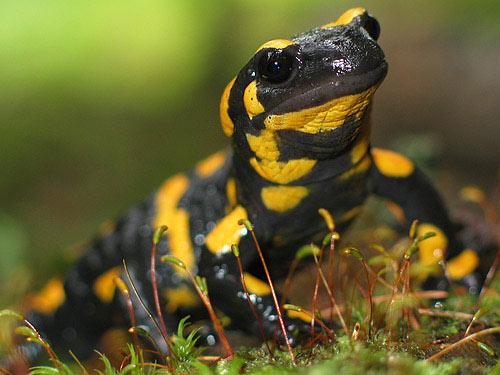Scientific classification
Kingdom: Animalia
Phylum: Chordata
Class: Amphibia
Order: Caudata
Family: Salamandridae
Genus: Salamandra
Species: S. salamandra
The fire salamander (Salamandra salamandra) is probably the best-known salamander species in Europe. It is black with yellow spots or stripes to a varying degree; some specimens can be nearly completely black while on others the yellow is dominant. Shades of red and orange may sometimes appear, either replacing or mixing with the yellow according to subspecies. Fire salamanders can have a very long lifespan. A salamander lived for more than 50 years in Museum Koenig, a German natural history museum.
Habitat, behaviour and diet
Fire salamanders live in forests in the hilly parts of southern and central Europe. They prefer deciduous forests, as they like to hide in the fallen leaves, but also at mossy tree trunks. They need clean small brooks in their habitat for the development of the larvae. Whether on land or in water, fire salamanders are inconspicuous. They spend much of their time hidden beneath stones, wood or other objects. They are active in the evening and the night, but on rainy days they are active in daytime as well.
Fire salamanders' diet consists of various insects, spiders, earthworms and slugs, but they also occasionally eat newts and young frogs. Small prey will be caught within the range of the vomerine teeth or by the posterior half of the tongue, which adheres the prey. The fire salamander can grow to be 15-25 cm long.[1]
Etymology
It is possible that the common name of this species, fire salamander, derives from old tales of these amphibians. The salamanders hide within holes and crevasses in damp wood and tree trunks. When humans cut down wood to use for heating, the salamanders often remained hidden within. When a fire was lit, the heat forced the animals to leave the wood and crawl to safety. Because of this they appeared as though they were "crawling from within the flames".
Reproduction
Males and females look very similar except during the breeding season, when the most conspicuous difference is a swollen gland around the male's vent. This gland produces the spermatophore, which carries a sperm packet at its tip. The courtship happens on land. After the male becomes aware of a potential mate, he confronts her and blocks her path. The male rubs her with his chin to express his interest in mating, then crawls beneath her and graps her front limbs with his own in amplexus. He deposits a spermatophore on the ground, then attempts to lower the female's cloaca into contact with it. If successful, the female draws the sperm packet in and her eggs are fertilized internally. The eggs develop internally and the female deposits the larvae into a body of water just as they hatch. In some subspecies the larvae continue to develop within the female until she gives birth to fully formed metamorphs. Breeding has not been observed in neotenic fire salamanders.
Toxicity
Salamanders may actively defend themselves once they are grasped by a predator. Besides various antipredator postures, S. salamandra adults are able to exude heavy toxic skin secretions, e.g. the neurotoxic alkaloid Samandarin. This alkaloid causes strong muscle convulsions and hypertension combined with hyperventilation in all vertebrates. The poison glands of the Fire Salamander are concentrated in certain areas of the body, especially around the head and the dorsal skin surface. The colored portions of the animal's skin usually coincide with these glands. Most of these secretions might be effective against bacterial and fungal infections of the epidermis, but some secretions could also be dangerous to human life.
Distribution
Fire Salamanders are found in most of southern and central Europe. They are most commonly found at altitudes between 400 and 1000 m, only rarely below (in Northern Germany sporadically down to 25 m). However in the Balkans or Spain they are commonly found in higher altitudes as well.
to 75 live babies over the course of several days. In most cases the larva are aquatic for two to four months, but some populations give birth to fully terrestrial neonates. This species hibernates underground during the winter and during hot and dry spells.
Alfred Edmund Brehm: Az állatok világa - Légrády testvérek (1905)
A Tudás Fája/ állatok/ Szalamandrák és gőték
http://hu.wikipedia.org/wiki/Foltos_szalamandra
http://www.fsz.bme.hu/mtsz/szakmai/szalaman.htm
